Every editorial product is independently selected, though we may be compensated or receive an affiliate commission if you buy something through our links. Ratings and prices are accurate and items are in stock as of time of publication.
Modern vehicle tires are tough, standing up well to rough terrain and thousands of miles of driving. Trouble is, tires are not invincible. Every so often car tires spring leaks. Air can start leaking from anywhere on a tire, and the location of the leak determines whether or not you can fix it yourself. And if you can't fix it yourself, the location of the leak will also tell you if you need a professional repair or a new tire.
Whether or not your tire is tubed or tubeless affects things, too, because only tubeless tires can be repaired using the technique of plugging that we'll show you here. The good news is that modern vehicles always have tubeless tires, and this means that repairing with a rubber plug is often an option.
Plugging a tubeless tire is only a possibility when your puncture is in the tread area. If the air leak is where the sidewall of the tire meets the rim — this is called a "bead leak" — you'll need to visit a mechanic with a tire machine to dismount the tire from the rim and remount it with sealing liquid applied to the bead. If your sidewall has been punctured, you need a new tire, because damage there can lead to a blowout at highway speeds, even after repair.
Learn exactly how to plug a tire so next time you spring a leak between your treads, you'll be able to get up and running again in record time.
Total time completing the repair is about 15 minutes. Doing the work yourself will save you about $20 and the time spent driving to the garage and waiting.
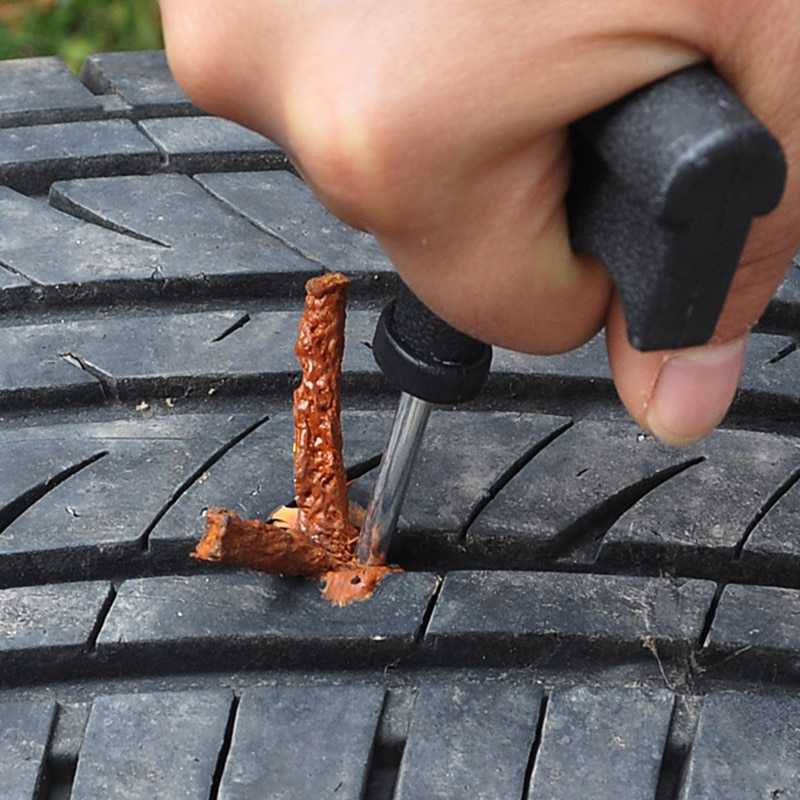
Steve Maxwell for Family Handyman
Complete DIY projects like a pro! Sign up for our newsletter!
Do It Right, Do It Yourself!
Originally Published: August 27, 2020
Plugging a tire is so simple and anyone can do it. You don’t have to even remove your tire to plug it.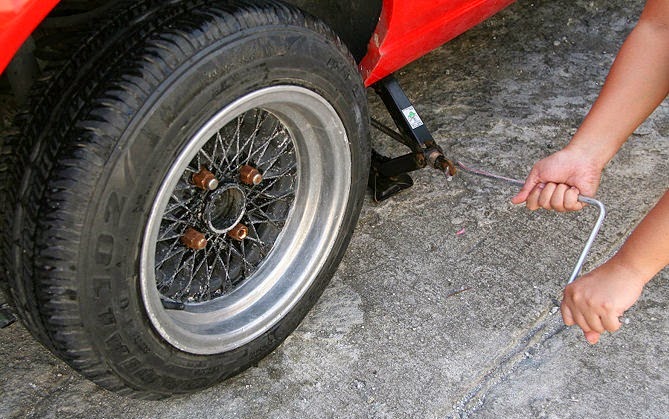 To clarify, you can fix your tire while it’s still on your car.
To clarify, you can fix your tire while it’s still on your car.
Advertisements
In addition, you don’t even have to deflate your tire to repair it. Above all, using a professional tire repair kit makes learning how to plug a tire an effortless process.
Universal Heavy Duty Tire Repair Kit
⭐️⭐️⭐️⭐️⭐️$19.99
Buy Now
*Amazon Affiliate Products*
There are a few factors to consider before determine if you can go on plugging a tire. The following should be considered:
Advertisements
The size of the puncture, the extent of the damage, and the tread of your tire. The size of the hole must be no larger than 0.25 inches and must be located on the tread of your tire.
Advertisements
If the puncture is on the shoulder or sidewall, then you will need to replace the tire.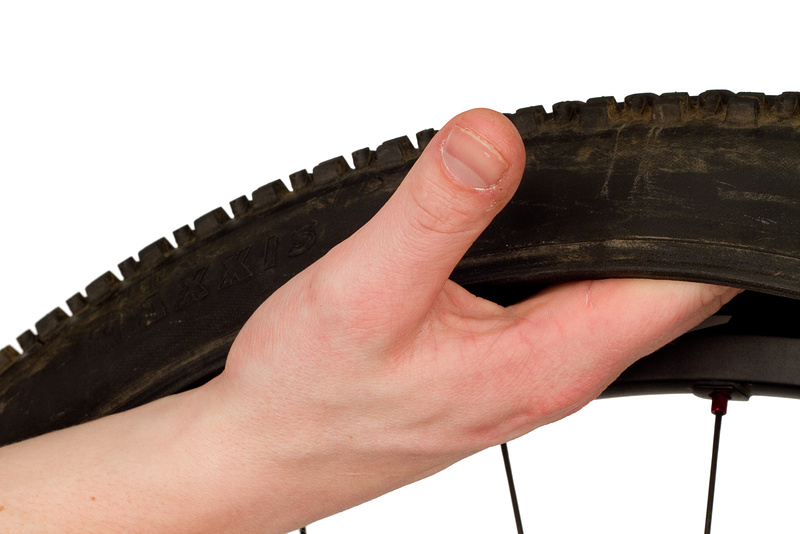
List of all Tools Needed
Please Note: Numerous tires can look fine on the outside, but have started to crumble on the inside. This is usually due to a tire running low on air.
Fix what’s wrong now, before it gets out of hand.
Tweet
This would get mighty expensive if it weren’t for the ability to patch a tire yourself. Don’t waste time and money bringing your tire to a shop, when you can do the job yourself faster and cheaper!
If you are trying to learn how to patch your tire step by step, then look no further. Here at God’s Wrench, we provide you with the knowledge you need for the job.
Time needed: 10 minutes.
Plugging a tire step by step
Check your tires PSI with an air pressure gauge. However, if one tire is significantly lower than the rest, this is most likely your leaky tire.
Fill your low tire up with air to the correct tire PSI.
Spray your whole tire with soapy water and look for bubbles. However, spraying your tire will require a spray bottle and dish soap.
Once the object is located, pull it out with pliers.
If the hole in your tire is to big for a plug it can not be fixed. Secondly, if the hole is on or too close to the sidewall of your tire, it can not be repaired. In addition, if your tire is too old, worn out, or there is too many plugs in the tire, fixing the tire is not an option.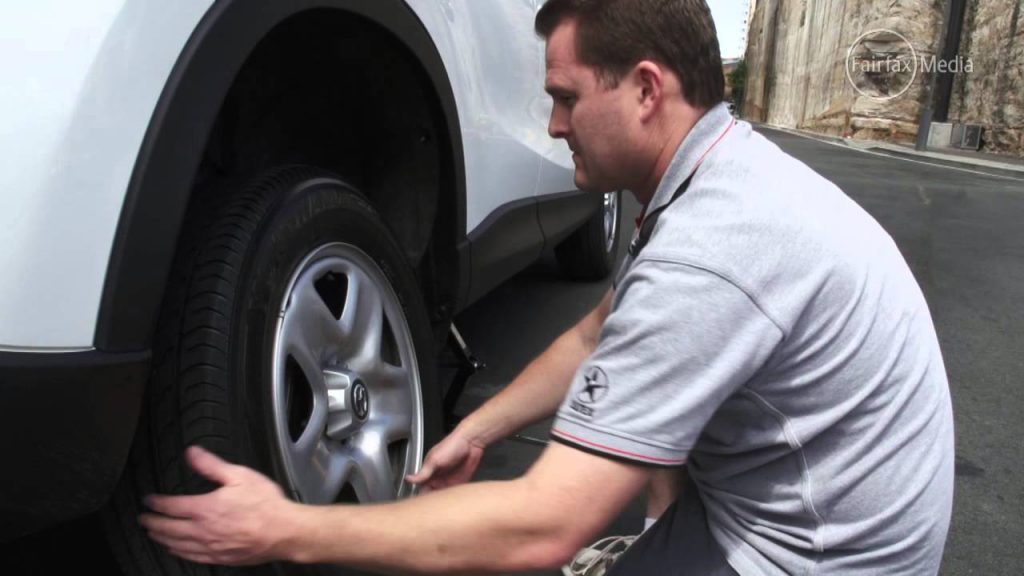
Once you have found the leak in your tire, use your reamer tool to widen the hole.
Slide the tire plug evenly through the eye of your plug tool. Secondly, push the plug through the hole in the tire until it’s at least half way through the tire. After that, pull your tire plug tool out fast and with force.
Inflate your car tires to the correct tire PSI.
Spray the tire plug with soapy water to make sure the repair held.
Is plugging a tire a permanent fix?
Tires can be repaired with a string plug (like the one displayed above). This patch may hold air for months, years even for the remaining life of the tire. For this reason, many consumers consider a string plug repair a permanent solution.
When should you not plug a tire?
Repairs should only be made on the tread or the tire. You should NOT repair a tire if the puncture is located on the shoulder or sidewall area. If this is your situation, the tire must be replaced. In addition to tires being replaced, punctures that are greater than ¼ of an inch or 6mm are prohibited.
How many times can you plug a tire?
Tire should be repaired no more than twice. Additionally, you should not repair a tire if two punctures are within 16 inches of one another.
0003Related materials
Tire inflation with nitrogen and 7 more wirings at the tire fitting
The tire manufacturer's instructions say to change shoes when the temperature drops below +7°C. In my opinion, it's too early. There are still a lot of cars with summer tires on the roads around. And at this temperature, the braking distance on studded tires may be even longer.
And at this temperature, the braking distance on studded tires may be even longer.
I advise you to change the wheels to winter ones when the temperature drops below zero at night. That's when it really is time, because in the morning an icy area may come across on the roads. At the same time, out of habit, it will seem very slippery.
Precisely in order to do it at the most correct and convenient time. The vagaries of the weather are unpredictable. Residents of the Rostov region, for example, say that sometimes during the winter period they rearrange the wheels from winter to summer and back several times.
Dismantling wheels (that is, dismantling a tire from a rim) at home is a difficult task that requires appropriate skills and knowledge. We will describe a simpler job that, in theory, any average motorist who does not have special tools and experience in tire fitting should be able to handle. And therefore we mean that you have a complete set of serviceable winter tires mounted on disks. You remember that in the spring they did not lose pressure, there are no cuts on them, and a couple of self-tapping screws do not stick out of the tread in addition to the spikes. And, most importantly, the tread height is more than 4 mm. These are the modern requirements for winter tires. If at least one of the conditions is violated, then it is better to solve the problem before the onset of the hot tire season.
You remember that in the spring they did not lose pressure, there are no cuts on them, and a couple of self-tapping screws do not stick out of the tread in addition to the spikes. And, most importantly, the tread height is more than 4 mm. These are the modern requirements for winter tires. If at least one of the conditions is violated, then it is better to solve the problem before the onset of the hot tire season.
Related materials
If I change wheels, do I need to balance them every season?
There are car owners who meticulously balance tires before each season. In my opinion, this is not justified by anything. I recommend installing the wheels on the car, then drive at different speeds, but not higher than your usual ones. If the imbalance (it is manifested by vibrations on the steering wheel or seat) is not felt, then balancing can be postponed until future seasons. In principle, winter tires can be balanced before being stored for storage: after all, the spring period for changing wheels in tire shops is more extended in time compared to autumn, and therefore the queues are noticeably shorter.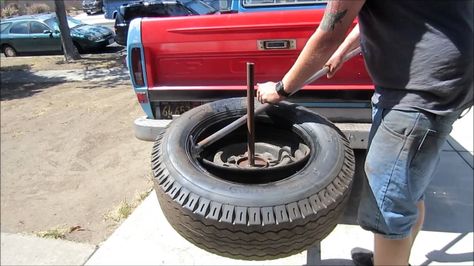
So we take the wheels out of storage. For one, this is the corner of the garage, for the other, a balcony, for the third, the warehouse of the nearest car service that provides a wheel storage service. Depending on storage conditions, tires may have different temperatures. Wheels removed from a warm room, having cooled down by 20 ° C, will lose about 0.2 bar of pressure, and gradually, as they cool down. Well, the cold ones have nothing to lose! Therefore, cold ones can be immediately pumped up to the nominal pressure, well, maybe 0.1–0.2 bar more, given that it will only get colder further. And warm tires must either be inflated with a large margin immediately, or set the pressure at the end of all work, when the air in them cools down.
If you use a standard jack, it is better to place a special stand under the car for insurance. Well, or at least place the spare wheel so that when it falls, the threshold lies on the rim, and not on the tire.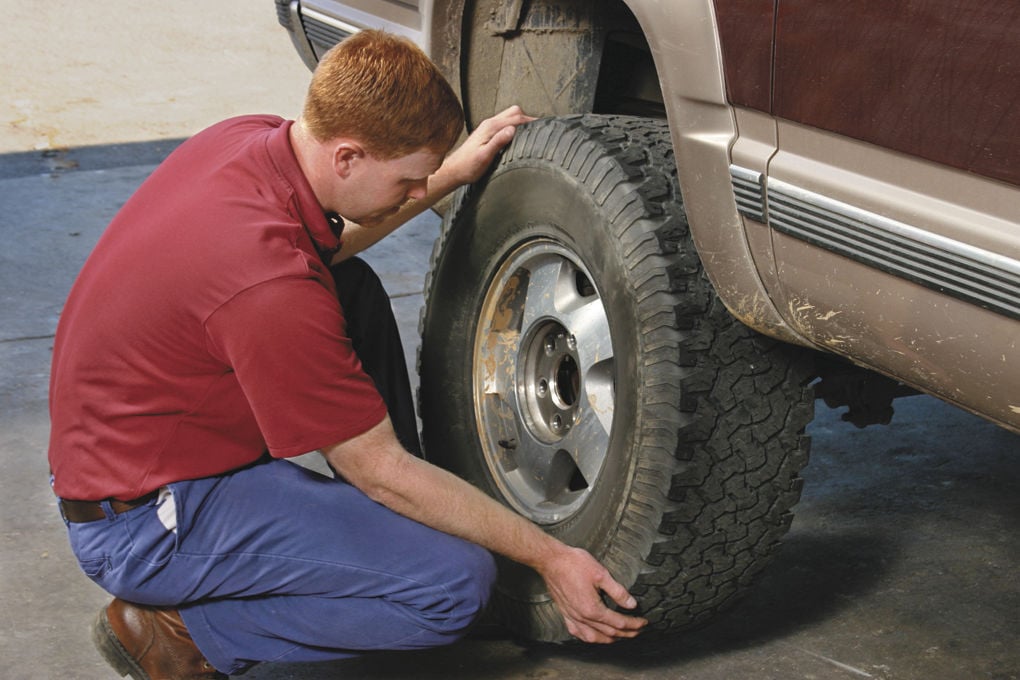 Please note that this will most likely damage the disc. Therefore, it is better to use an old unnecessary wheel.
Please note that this will most likely damage the disc. Therefore, it is better to use an old unnecessary wheel.
If you use a regular jack, it is better to place a special stand under the car for insurance. Well, or at least place the spare wheel so that when it falls, the threshold rests on the rim, and not on the tire. Please note that this will most likely damage the disc. Therefore, it is better to use an old unnecessary wheel.
Related materials
Which jack is better? — expert examination of the ZR
We find a flat area with a hard surface. If you change wheels yourself twice a year, then I strongly advise you to get a convenient jack. At least small and inexpensive, but rolling. It is noticeably more reliable and durable than the regular one that was equipped with your car. It is advisable to use a balloon wrench with a cruciform or with an extended handle - it is more convenient than the standard one attached to the car.
Prepare a wheel stop - yes, at least half a brick. Inspect the secret key for damaged code elements and clean the secret nuts/bolts on all wheels.
If the winter set of wheels has different disc characteristics, remember if spacers are needed between the disc and the hub lug - they should be prepared in advance.
The wheel jack is based on a hydraulic cylinder. Raises quickly, and lowers even faster.
The wheel jack is based on a hydraulic cylinder. Raises quickly, and lowers even faster.
 We put an emphasis under the wheel, located diagonally from the one we are going to shoot.
We put an emphasis under the wheel, located diagonally from the one we are going to shoot.  Do not overdo it. In almost all cars, except for large SUVs, the tightening torque does not exceed 100–110 N∙m. That is, on a convenient half-meter key, the force should not exceed 20 kg. Jumping on the key is definitely not worth it! The lock is tightened last and with a slightly lower torque than the rest of the nuts / bolts.
Do not overdo it. In almost all cars, except for large SUVs, the tightening torque does not exceed 100–110 N∙m. That is, on a convenient half-meter key, the force should not exceed 20 kg. Jumping on the key is definitely not worth it! The lock is tightened last and with a slightly lower torque than the rest of the nuts / bolts. Just in case, after the first ride, check the tightness of the wheel fasteners, and the next morning, check the tire pressure.
Our new video
An interesting (and inexpensive) car from Lipetsk: everything is different here!
Test of the most affordable (well, almost) crossover for the family
Test of the new Chinese crossover Skywell ET5
Like this post? Subscribe and you will always be in the know!
Driving on Yandex.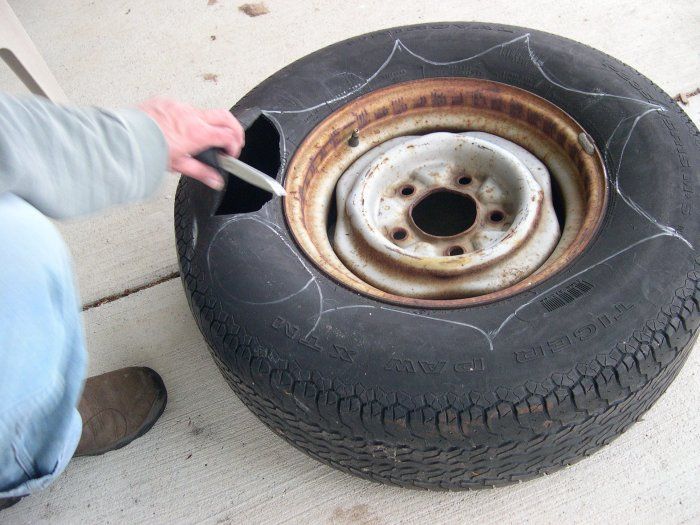 Zen
Zen
News smi2.ru
The annual replacement of winter tires, as a rule, follows a similar scenario - with the onset of frost, the first snow and ice, drivers take their winter tires from balconies or garages and massively are sent to tire centers or just the nearest tire fitting points.
Winter is coming very soon! It's time to prepare for it properly.
But will the work done in a nameless service be of high quality and safe? How to change summer tires for winter?
Winter tires Nokian Tires and the first snow
Here are some tips from Vianor's experts to make sure you've done everything you need to drive safely on winter roads!
Drivers who have lost control of their car in icy or snowy conditions are frequent customers of car services. Both tire fitting and body shop. However, winter tires do not require changing them only when frost sets in. The design of winter tires is such that they begin to work effectively even at an average daily temperature of plus 7 degrees Celsius. And summer tires at this temperature already begin to work incorrectly: the rubber compound hardens and does not provide proper grip.
However, winter tires do not require changing them only when frost sets in. The design of winter tires is such that they begin to work effectively even at an average daily temperature of plus 7 degrees Celsius. And summer tires at this temperature already begin to work incorrectly: the rubber compound hardens and does not provide proper grip.
And don't be put off by the smiles of your neighbors or colleagues who put off changing tires until the last moment - they say, "it's too early." All this was described by the legendary Aesop in ancient Greece in his fable "The Beetle and the Ant", known to us from the translation of I.A. Krylov of her remake from Jean La Fontaine (in the Russian version - "Dragonfly and Ant"). “Summer red sang; I didn’t have time to look back, As winter rolls into my eyes.
It is better to make an appointment at the Vianor tire center in advance, and you will be received at the agreed time and without the need to waste precious time in line.
In Vianor tire centers, the technicians carefully check the condition of the winter tires brought by the customer before starting the replacement. In some cases, we recommend replacing tires with new ones. In some tire shops, unfortunately, they often put the tires brought by the client on the car almost without looking - just pay the money. It is not safe! After all, there is a whole set of signs that the tires have already exhausted their resource and can seriously let you down on the road - up to the complete destruction of the tire, followed by an accident and other sad consequences.
The very first parameter of tire wear is the remaining tread height. According to Russian legislation, for winter tires it must be at least 4 mm. You can check this not only with a caliper, but also with a simple match, the height of the sulfuric head of which is 3-4 mm. When immersing a match between the tread lamellas, the sulfur head must be completely hidden from view.
When immersing a match between the tread lamellas, the sulfur head must be completely hidden from view.
Most modern tires have built-in wear indicators. Nokian Tires, for example, have a DSI (Driving Safety Indicator) wear indicator on the central block of the tread, showing the value of the residual tread height of the tire in millimeters. The initial tread height of new Nokian Tires winter tires is on average 8-9 mm.
Tread height is not the only thing to consider. Damage such as splitting or cracking of the tread, bulges or other damage to the sidewall of the tire is a clear indication that it needs to be replaced. But if a self-tapping screw is suddenly found between the tread blocks, it can be easily repaired.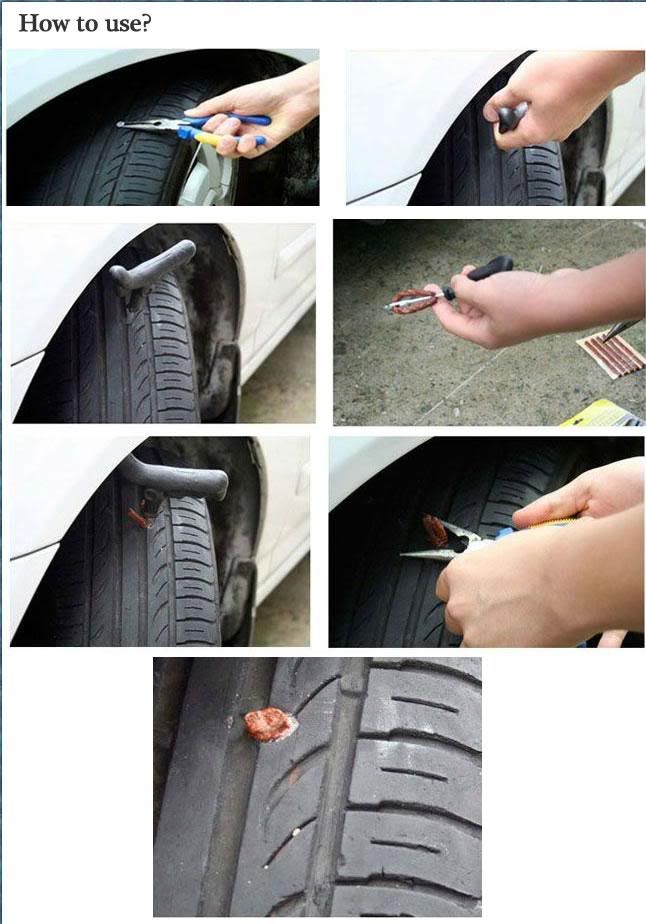 The exception is run flat tires, most manufacturers of which exclude the possibility of repair.
The exception is run flat tires, most manufacturers of which exclude the possibility of repair.
Uneven tread wear should also attract your attention - when the shoulder area is worn much more than the central one and vice versa. In such a situation, variants with incorrect tire pressure or “left” wheel alignment angles are possible - wheel alignment may be required.
In Vianor centers, if such a service is available, they will always help you to make a high-quality wheel alignment
Nokian Tires experts, however, emphasize that a slight difference in the nature of tread wear is acceptable, because tires on a drive axle wear out more in the central part of the tread, while in freely rotating tires, the shoulder part. That is why the company recommends rearranging the wheels from one axle to another every 8 thousand kilometers. Another recommendation from Nokian Tires is that tires in the best condition (with the least wear) should always be mounted on the rear axle of the car and not on the front, even if your car is front-wheel drive. Finnish experts explain this by the fact that in an emergency it will help to avoid skidding of the rear axle associated with loss of traction, which is much more dangerous than skidding of the front axle.
Finnish experts explain this by the fact that in an emergency it will help to avoid skidding of the rear axle associated with loss of traction, which is much more dangerous than skidding of the front axle.
On studded tires, pay attention to the number of loose studs. For example, according to the experts of the tire research and development center "Kama", the loss of more than 10% of anti-skid studs, especially in one tread area, will no longer allow the tire to demonstrate its original characteristics. The company recommends replacing such tires with new ones. Other manufacturers have similar recommendations.
The tire fitting process looks simple, but it is only at first glance - there are a large number of nuances that only a professional can take into account. “By eye” it is not easy for an ordinary person to determine the performance of tire fitting equipment or the qualifications of a master. Therefore, we will show you how a regular winter tire change takes place at one of the Vianor tire centers.
Tire Center Vianor in Moscow at Varshavskoe Shosse, 150
First of all, the car is installed on a hydraulic lift using high rubber buffers to prevent damage to the elements of the bottom of the car. Using rolling jacks is, of course, much cheaper for the service, but unsafe and inconvenient.
Vianor tire centers use modern equipment
Craftsmen use pneumatic tools to unscrew the wheels, passing them to the washing area.
Tire washing. In the largest Vianor tire centers, one lift has its own individual car wash, tire changing and balancing machine, as well as a complete set of tools. This means that work can take place simultaneously at several posts.
Specialized automatic car washes, which use a special shampoo, allow you to clean the wheel from reagents and other contaminants - so the customer's summer tires will be clean and the wheels will be maximally prepared for tire fitting work.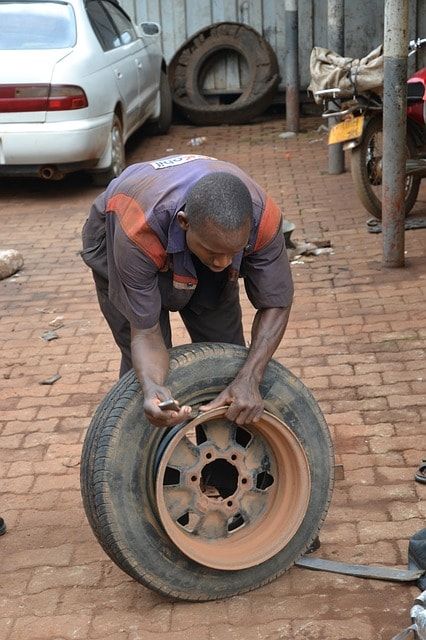 Even a small piece of adhering dirt or bitumen can adversely affect tire balance.
Even a small piece of adhering dirt or bitumen can adversely affect tire balance.
After washing, the wheels are dried with compressed air and transferred to the tire changer. The wheel is carefully disassembled. The valve is changed to a new one - far from all tire shops do this, however, the poor condition of the valve is especially often the cause of a “sudden” loss of pressure in the tire.
Replacing the valve with a new one
We recommend changing the valves every time you change tires - it's not expensive at all. By the way, valve replacement is sometimes included in the free tire fitting service, which we offer to customers during the promotion period, when purchasing a number of tire models.
The next step: a new tire is installed on the disk, taking into account the direction of its rotation, if the tire is directional.
Installing a winter tire on rim
The assembled wheel is then sent to the balancing machine.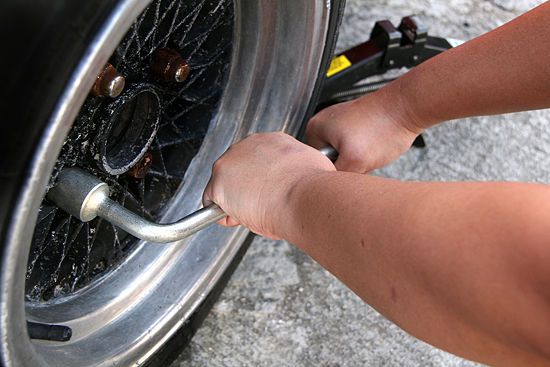 In the Vianor tire center on Varshavskoe Shosse, the most modern and efficient machines are precise and easy to use.
In the Vianor tire center on Varshavskoe Shosse, the most modern and efficient machines are precise and easy to use.
Depending on the design of the rim, as well as the existing imbalance, the master sets the weights of the required type and weight.
Wheel balancing
The contact surface of the spoke and stud is cleaned and lubricated with special grease. It protects the connection between the hub and the disc from corrosion and sticking. The wheels are pre-spun using pneumatic tools.
The so-called copper grease protects the hub-rim connection from corrosion
The tires are set to the pressure recommended by the vehicle manufacturer. Please note that some winter tire manufacturers advise increasing tire pressure in winter - they recommend keeping winter tires at 0.2 bar (20 kPa) more pressure than summer tires.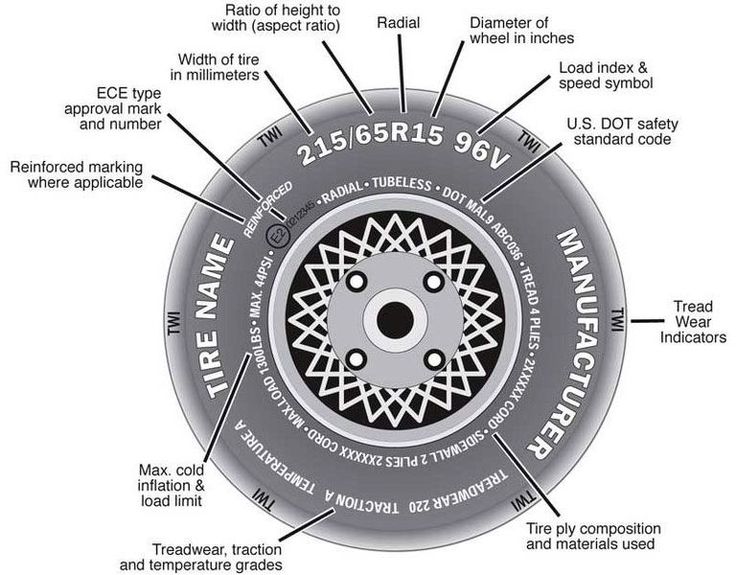 The tire pressure must always be checked with cold tyres.
The tire pressure must always be checked with cold tyres.
The last step, if you do not take into account the neat packaging of summer tires in branded bags and then in the trunk of the client, is the final tightening of the wheel nuts. This process is carried out with the car standing on the floor of the workshop strictly using a torque wrench adjusted to the correct tightening torque.
Hand tightening of all wheel nuts with a torque wrench is very important.
This eliminates two possible serious problems at once - overtightening of the studs, and, conversely, insufficient tightening of the threaded connection. The first option can lead to the breakage of the stud, the second - to the loss of the wheel on the move. When performing tire fitting work in Vianor tire centers, you will not encounter such problems.
To prolong the life of your new winter tires, we recommend avoiding sudden acceleration, braking and cornering as well as high speed driving for the first 500 kilometers. This is especially important when using "studs" - the seats for studs on most of these tires are designed in such a way that for the final "landing" of the stud, the tire must be "rolled" to avoid premature loss of studs.
It is possible to get into an accident on a slippery road with good tires, if you do not take into account the decrease in the level of grip with the surface, speeding, not keeping your distance and making dangerous maneuvers. We encourage careful driving all year round.
Careful driving after tire fitting has another hidden meaning - adapting the driving style to the road conditions that have changed after the cold snap. Most of the so-called "tinsmith days" happen for two reasons - the driver delays the moment of changing tires until the last moment, and the loss of winter driving skill, which implies a much lower base level of grip on the surface.
Unfortunately, not all car owners think that storing winter tires on the balcony is not the best possible idea. Temperature fluctuations, direct sunlight and storage of dismantled tires in a pile can quickly destroy even the best tires.
Proper storage of tires looks like this: tires without rims are stored on a rack or a special wooden stand; once every two weeks they must be rotated by 90 degrees (quarter of a turn) for protection against deformation. Long-term storage of tires in a stack or hanging is unacceptable. Complete wheels, on the contrary, cannot be stored standing up - only in a stack or suspended. When stored in a stack, tires should be repositioned once a month.
Tires must be kept clean, a special tire preservative may be used. Tires should be stored in a cool, dry place at temperatures between 0 and 15 degrees Celsius. Exposure to direct sunlight and moisture is excluded, placement of tires near heating radiators.